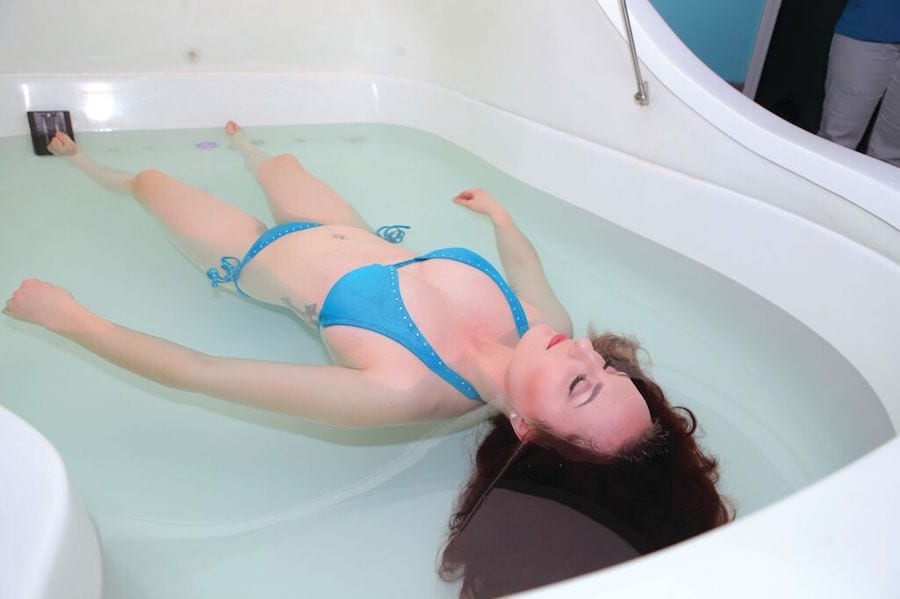Believers say flotation therapy resets the mind and body
By Hank Sforzini
Photographs by Josh Norris
The purported benefits of flotation therapy are numerous — stress management; reducing chronic pain, depression, and insomnia; improved athletic performance and recovery; and boosted creativity and focus.
For Deborah Helms, a former vice president of Fortune 500 company CarMax, it’s not hyperbolic to say flotation therapy saved her life.

Deborah Helms
One day three years ago, Helms awoke and didn’t recognize anyone: “I lost my memory and vocabulary,” she said. At the time, Helms believed it was stress induced and that she was sleep deprived. Her neurologist diagnosed her with trigeminal neuralgia, a chronic pain disorder that’s considered to be one of the world’s most agonizing diseases — even mild stimulation such as brushing your teeth may trigger a jolt of excruciating pain.
Medication would temporarily numb Helms’ pain, but the side effects were debilitating. After 19 months of suffering, she decided to take her condition into her own hands. At the suggestion of her chiropractor, she tried flotation therapy.
“The very first time I floated, my pain was gone,” she says.
Three years later, she’s weaned herself off all doctors and medications, and manages her condition through floating alone. Now, Helms runs one of Georgia’s three flotation therapy centers, Infinity Floating, in Braselton, Georgia. In 2015, there were 267 float centers in the U.S., up from an estimated 85 in 2011, and that number continues to grow, according to published reports.
Flotation therapy was pioneered by postwar neurophysiologist and psychoanalyst John C. Lilly, best known for his research with dolphins. Lilly, who first worked at the Naval Institute, and later at the National Institute of Mental Health, was working towards the goal of isolating the brain from normal perceptual experience when he invented flotation tanks. Flotation enjoyed mild popularity before falling out of fashion in the ’80s due to health concerns during the AIDS panic. However, in recent years, floating has come into favor once again.
Here’s how the process works: sessions usually last anywhere between 60-90 minutes and costs $60-$100 an hour. Typically, flotation tanks contain six to 12 inches of water and often hold more than 1,000 pounds of pharmaceutical-grade Epsom salts. The buoyancy created by the water’s salinity allows users to float effortlessly — giving the feeling of a gravity-free environment. Since the solution is kept at body temperature, it obscures your normal sensations because you lose track of where your limbs end and the water begins. Your ears stay just below the water line, and the tanks are insulated against sound so outside noise can’t reach you. Once the door is closed, no light reaches the floater allowing for total sensory deprivation — a welcome experience in today’s world where we are frequently bombarded by countless stimuli. It gives the body the opportunity to deeply rest, de-stress and heal.
While each person’s individual experience is different, everyone benefits the same physiologically.
Circulation opens up from the top of your head to the tips of your toes. The salt pulls inflammation from the body. Floating positively resets stress response hormones, including cortisol and epinephrine, and increases dopamine and endorphin levels, which boost your mood.
“People were created in a warm, salty solution at zero gravity,” says Helms. “The body is allowed to function the way it was designed to.”
According to Helms, her clients run the gamut from suburban moms and teenagers to professional athletes, including MLB and NFL stars.
“We see college students suffering finals fatigue, middle-aged marathoners, CrossFit enthusiasts, and parents who bring kids in before the big basketball championship or the ACT,” says Helms. “I have watched athletes limp in and jog out.”
For athletes, floating offers a multitude of benefits. JP O’Connor, an Olympic target shooting coach, was first introduced to floating by a fellow coach.
“It dramatically improved a student’s shooting performance, which was reflected in his scores,” he said.
Floating tanks vary in style, but all use enough Epsom salts to create buoyancy, allowing the user to experience a gravity-free environment in six to 12 inches of water.
O’Connor, who uses flotation therapy personally and also encourages his students to use it, regularly conducts high-performance camps and clinics at the U.S. Olympic Training Center in Colorado Springs, Colorado. As a lifelong student of high-performance psychology, O’Connor praises flotation therapy as a way to improve mindfulness, a key attribute of athletic excellence. He also acknowledges the physical benefits for athletes at all levels because of the therapy’s ability to relax both fast and slow-twitch muscles.
Flotation therapy is also becoming more popular with women who are pregnant to help ease inflammation and diminish added weight, thus taking the strain off the body and spine. It also serves as a communal experience.
“The connection is heightened when you have both mother and child at zero gravity,” said Helms.
Additionally, after giving birth, new mothers who battle postpartum depression and anxiety find flotation therapy beneficial.
Helms says the most common objections are feelings of claustrophobia and hygiene. For those who are claustrophobic, there’s always the option of floating with the door partially or completely open, and most tanks have interior lights. As for the issue of hygiene, float centers must adhere to state health department standards and meet the same level of cleanliness found in hospitals. Due to the amount of salt, no microorganism or bacteria is heavy enough to penetrate, let alone survive the solution.
Helms will be the first to tell you she’s not a medical expert, but she’s a believer.
Said Helms: “I’ve seen 1,500 people come through Infinity’s doors in the last 16 months. I’ve seen Parkinson’s, dementia and diabetes improve. I’ve seen ringing in the ears cured. I’ve had customers with plantar fasciitis who had to pause before placing their feet on the floor able to bounce out of bed.” E
Infinity Floating has moved to a new facility at 32 Johnson Drive, Braselton, Ga. 30517. For more information, visit infinityfloating.com.

